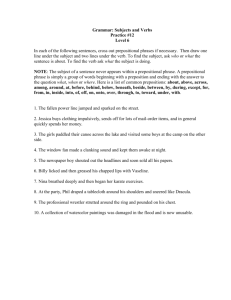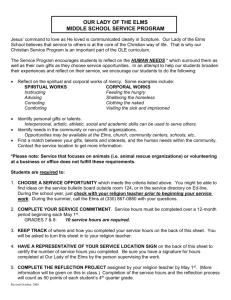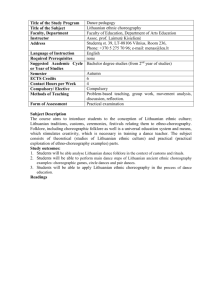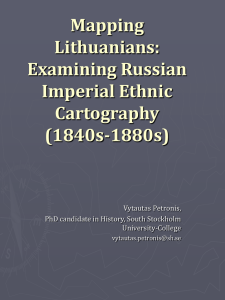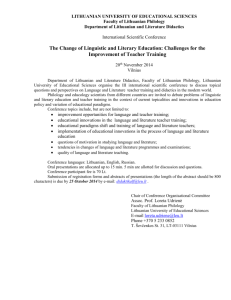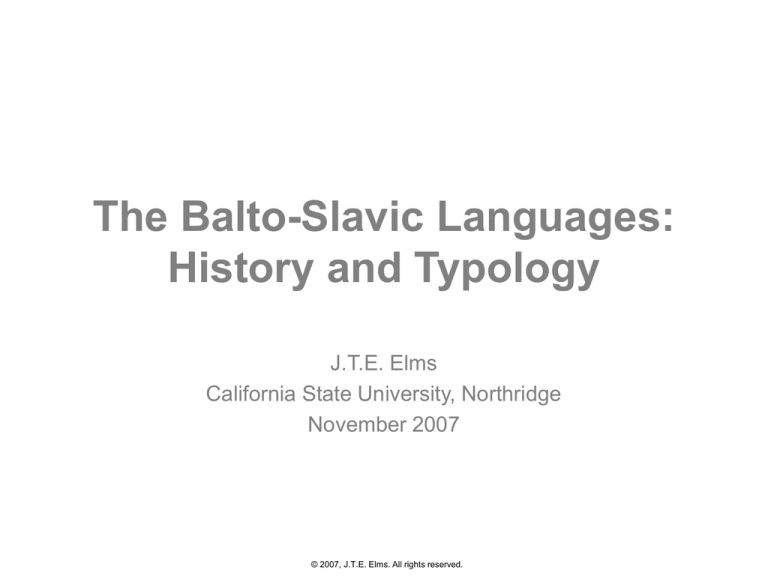
The Balto-Slavic Languages:
History and Typology
J.T.E. Elms
California State University, Northridge
November 2007
© 2007, J.T.E. Elms. All rights reserved.
Balto-Slavic Origins
Celtic
Romance
Germanic
Lithuanian
Latvian
Slovenian
Macedonian
Bulgarian
Serbo-Croatian
Sorbian
Czech
Slovak
Polish
Ukrainian
Byelorussian
Russian
Albanian
Iranian
Indic
Greek
Armenian
PIE
Tocharian
Hittite
8500 BP
7500
6500
5500
4500
3500
© 2007, J.T.E. Elms. All rights reserved.
2500
1500
500
Present
Lexical Distance Among European Languages
© 2007, J.T.E. Elms. All rights reserved.
Balto-Slavic Cognates
• Cognates have similar phonological form, syntactic form, & meaning
• Common cognates suggest common origin:
– Shared historical (“genetic”) ancestor, followed by isolation & drift
– Contact & borrowing from unrelated contemporary source
“mother”
“hand, arm”
“king”
“ten”
“go”
matj, materinskij
rjka
korolj
desjatj
hoditj, idti
matu, matir
ruka
korolj
dεsjatj
xodutu, itu
Bulgarian (SE)
majka
rjka
kral
dεsεt
hodja
Slovenian (SW)
mati, matisa
roka
kralj
deset
hoditi, iti
Serbo-Croatian (SW)
majka, matεrinski
ruka
kralj
dεsεt
otijsi, ijsi
Czech (W)
matka, matεřski:
ruka
král
dεsεt
hodit sε, xod
Polish (W)
matka
rεka
krόl
ʤiεsiεʨ
ists
mote, motina
rankų
karalius
dæ∫imt
eiti
mate
roka
karalis
dεsmits
iet
Slavic
Russian (E)
Ukrainian (E)
Baltic
Lithuanian
Latvian
© 2007, J.T.E. Elms. All rights reserved.
Balto-Slavic Phonology:
Satem (vs Centum) Velar Development
Satem
Centum (Kentum)
•
Palatalized velars sibilants: kj s, ʃ; gj z, ʒ
– PIE *kjmtom-, “hundred” Lithuanian ʃimtas, “hundred”
Russian sto, “hundred”
jh
– PIE *g el-to-, “golden” Lithuanian ʒeltas, “gold”
Polish zloty, “gold piece, unit of currency”,
•
Plain, aspirated, & labialized velars plain velars: k, kw k; g, gh, gw, gwh g
–
–
–
•
PIE *kwos, “who”
Lithuanian kàs, “who”
wh
PIE *sneig -o-, “snow” Russian sneg, “snow”
PIE *gwerh-, “consume” Lithuanian geriù, “I drink”
Centum exceptions are numerous (e.g. Lithuanian geltas, “yellow”)
© 2007, J.T.E. Elms. All rights reserved.
Vowel Systems
•
Typically 5 or 6 basic vowel phonemes
–
–
–
•
•
51% of world languages fall in this range (World Atlas of Language Structures)
Slovenian is an exception with 8 vowels, Latvian with 7
Contrast Germanic family with up to 14 basic vowels, largest inventories in the world
Vowels have null allophones, eg Russian [djεn], “day” (NOM) vs [djn.a], “day” (GEN)
Tone or pitch accent present in many languages
Basic Inventory
Size
Meaningful Contrasts
/i, ε, a, o, u/
5
• Stressed/unstressed
• With/without palatal onglide /ji, je, ja, jo, ju/
Ukrainian (E)
/i, ɪ, ε, ɑ, ɔ, u/
6
• Stressed/unstressed
• With/without palatal onglide /ji, jɪ, jε, jɑ, jɔ, ju/
Bulgarian (SE)
/i, ε, ə, a, ɔ, u/
6
• Stressed/unstressed
• With/without palatal onglide for /ja, ju/
Slovenian (SW)
/i, e, ε, ə, a, ɔ, o, u/
8
• Stressed-long/unstressed-short
• Rising/falling pitch accent in stressed syllables
/i, ε, a, ɔ, u/
5
• Long/short duration
• Rising/falling pitch accent in stressed syllables
Czech (W)
/i, ɪ, ε, a, o, u/
6
• Long/short duration (except tense/lax on /i:/ vs /ɪ/)
Polish (W)
/i, ɪ, ε, a, ɔ, u/
5
• Nasalized/nonnasalized
/i, ε, æ, ɐ, o, u/
6
• Stressed/unstressed
• Long/short duration (except /e:/ always long)
/i, e, ε, æ, a, o, u/
7
• Long/short duration
• 3 tones on long vowels & dipthongs:
high level (eg [luo˦ki], “chives”)
falling (eg [lùoks], “arch, bow”)
rising-creaky-falling (eg [luôgs], “window”)
Slavic
Russian (E)
Serbo-Croatian (SW)
Baltic
Lithuanian
Latvian
© 2007, J.T.E. Elms. All rights reserved.
Consonant Systems
•
Typically 22 - 45 consonant phonemes; half ≥ 30, large to very large inventories
–
–
–
•
World average consonant inventory size is 22 phonemes (World Atlas of Language Structures)
Only 9% of world languages have ≥ 34 consonants (WALS)
Compare Germanic with 21-25 consonants (32% of world languages fall in this range – WALS)
“Hard” (unpalatalized) vs “soft” (palatized) consonants are usually contrastive
–
–
Russian: мат /mat/, “checkmate” vs мать /matj/, “mother”; нос /nos/, “nose” vs нёс /njos/, “(he) carried”
But Latvian: noncontrastive allophonic palatalization of /k, g, l, n/, eg /n/ [ŋ]/_ {k,g} in [baŋka], “bank”
Size
Stops
Fricatives & Affricates
Approximants Nasals
Russian (E)
36
/p, b, t, d, k, g/
/pj, bj, tj, dj, ç/
/f, v, s, z, ʃ:, ʒ:, ts, ʧ, x/
/fj, vj, sj, zj, ʧj/; /ʂ, ʐ/ (retroflex)
/r, l, j/
/rj, ʎ /
/m, n/
/mj, ɲ/
Ukrainian (E)
33
/p, b, t, d, k, g/
/tj, dj/
/f, s, z, ʃ, ʒ, ts, dz, ʧ, ʤ, x, ɦ/
/fj, sj, zj, tsj, dzj/
/ʋj, r, l, j/
/ʋj, rj, ʎ /
/m, n/
/ɲ/
Bulgarian (SE)
36 (39)
/p, b, t, d, k, g/
/pj, bj, tj, dj, ç, gj/
/f, v, s, z, ʃ, ʒ, ts, (dz), ʧ, ʤ, x/
/fj, vj, sj, zj, tsj, (dzj),(xj)/
/r, l, j/
/rj, ʎ /
/m, n/
/mj, ɲ/
Slovenian (SW)
22
/p, b, t, d, k, g/
/f, s, z, ʃ, ʒ, ts, dz, ʧ, ʤ/
/ʋ, l, ɾ, j/
/m, n, ɲ/
Serbo-Croatian (SW)
24
/p, b, t, d, k, g/
/ʋ, l, r, j/
/ʎ/
/m, n/
/ɲ/
Czech (W)
24 (27)
/p, b, t, d, k, g/
/ç, gj/
/f, s, z, ʃ, ʒ, ts, ʧ, ʤ/
/ʧj, ʤj/
/(f), v, s, z, ʃ, ʒ, ts, (dz), ʧ, (ʤ), x, ɦ/
/l, r, j/
/r̝/ (fricative)
/m, n/
/ɲ/
Polish (W)
32
/p, b, t, d, k, g/
/ç, gj/
/f, v, s, z, ʃ, ʒ, ts, dz, ʧ, ʤ, x/
/ʂ, ʐ, tʂ, dʐ/ (retroflex)
/w, l, r, j/
/ʎ/
/m, n/
/mj, ɲ/
Lithuanian
39 (45)
/p, b, t, d, k, g/
/pj, bj, tj, dj, ç, gj/
/(f), s, z, ʃ, ʒ, ts, dz, ʧ, ʤ, (x), (ɣ)/
/(fj), sj, zj, ʃj, ʒj, tsj, dzj, ʧj, ʤj, (xj), (ɣj)/
/ʋ, l, r, j/
/ʋj, ʎ, rj/
/m, n/
/mj, ɲ/
Latvian
20 (22)
/p, b, t, d, k, g/
/(f), v, s, z, ʃ, ʒ, ts, dz, ʧ, ʤ, (x)/
/ l, r, j/
/m, n/
Slavic
Baltic
© 2007, J.T.E. Elms. All rights reserved.
Syllable Structures
•
Very complex syllable structures
–
–
–
–
–
Only a third (31%) of world languages allow syllables more complex than (C)(C)V(C) — WALS
Balto-Slavic allows up to four segments in syllable onset, eg Russian встретить ['fstrjetj.ɪtj], “to encounter”
Balto-Slavic allows up to five segments in syllable coda, eg Polish [skɔmpstf], “stinginesses” (GEN PL)
Sonority hierarchy weakly enforced, mostly in largest consonant clusters & in onsets
Russian one-syllable examples: взгляд /vzgliad/, “look”; монстр /monstr/, “monster”
•
Syllables without vowels
•
Compare Germanic (C)(C)(C)(V)(C)(C)(C)(C), eg English “strengths” [strεŋ{k}θs], “bottle” ['bɑt.l̩ ]
–
–
–
Syllable nuclei allow approximants, liquids, and nasals as well as vowels, eg Czech [zmrz.lɪ.na], “ice cream”
Null allophones for vowels means entire words may be vowelless, eg Russian [v], “in”; [s], “with”; [k], “to”
Exceptions: Polish, Lithuanian require a vowel in every syllable
Syllable
Structure
Example
Consonant Clusters
Consonantal
Nuclei
Russian (E)
(C)(C)(C)(C)(V)(C)(C)(C)(C)
fspr-, fspl-, fstr-, fskr-, fsxl-, vzbr-, vskr-, vzbl-, vzdr-, vzgr- vzgl-,
spr-, spl-, str-, stl-, stv-, skr-, skl-, smr-, fkr-, fkl-, zbr-, zbl-, zdr-,
zgr-, zgl-, zgn-, vgl-, vzb-, vzv-, vbr-, vsk-, sxv-, ..., -bsk, -nstr
/j,r,l,m,n/
Czech (W)
(C)(C)(C)(C)(V)(C)(C)(C)
tʃtv-, smr-, sml-, xtʃ-, vʒd-, zvl-, prʃ- ...
/r,l,m,n/
Polish (W)
(C)(C)(C)(C)V(C)(C)(C)(C)(C)
zjbjdw-, zskl-, ptʃl-, pstr-, dsk-, tsk-, tʃst-, tʃʃts’-, vrjb-, vrjx-, sml-,
None
Slavic
ʃrp-, vln-, klb-, xlm-, mgl-, ..., -lʃtʃ, -rʃtʃ, -rstf, -mstf, -pstf,
-mpstf
Baltic
Lithuanian
(C)(C)(C)V(C)(C)(C)(C)
skr-, ksl-, ..., -rbk, -rbs, -kʃt, -nkst
© 2007, J.T.E. Elms. All rights reserved.
None
Morphosyntactic Categories
Russian (Slavic)
Lithuanian (Baltic)
German (Germanic)
Parts of
Speech
Noun, pronoun, number, verb,
preposition, adjective, adverb,
conjunction, particle, interjection;
no article
Noun, pronoun, number, verb,
preposition, adjective, adverb,
conjunction, particle, interjection;
no article
Noun, pronoun, number, verb,
preposition, adjective, adverb,
conjunction, particle, interjection,
article
Person
First, second, third
First, second, third
First, second, third
Number
Singular, (dual), plural
Singular, (dual), plural, (indefinite)
Singular, plural
Formal, familiar
Formal, familiar
Formal, familiar
Masculine, feminine, neuter;
animate, inanimate
Masculine, feminine, neuter,
common
Masculine, feminine, neuter;
no common gender,
no animate/inanimate
Nominative, accusative, dative,
genitive, instrumental,
prepositional
Nominative, accusative, dative,
genitive, instrumental, locative,
vocative, (illative)
Nominative, accusative, dative,
genitive
Definite, indefinite
Definite, indefinite
Definite, indefinite
Politeness
Gender
Case
Definiteness
Degree
Positive, comparative, superlative Positive, comparative, superlative,
attenuated
Unmarked, comparative,
superlative
Tense
Past, non-past
Present, past, future
Past, non-past
Aspect
Completive/perfective,
progressive/imperfective,
iterative/probabilistic, unary
Completive/perfective,
progressive/imperfective,
iterative/probabilistic
Completive/perfective,
progressive/imperfective
Voice
Active, passive, reflexive
Active, passive, necessitative
Active, passive, reflexive
Mood
Indicative, imperative,
interrogative, infinitive
Polarity
Positive, negative
Indicative, subjunctive, imperative,
Indicative, subjunctive,
interrogative, infinitive,
imperative, interrogative, infinitive
indirect evidentiality
Positive, negative
© 2007, J.T.E. Elms. All rights reserved.
Positive, negative
Morphosyntactic Features Per Case
21
Hungarian
14
Finnish
Lithuanian
7
Serbo-Croatian
7
6
Russian
4
German
2
English
0
5
10
15
Source: Pirkola & Kittunen, 2007
© 2007, J.T.E. Elms. All rights reserved.
20
25
Index of Synthesis
Inuit (Eskimo)
3.72
Russian
3.33
Turkish
2.86
Swahili
2.55
Old English
2.12
English
1.68
Yoruba
1.09
Vietnamese
1.06
1
1.5
2
2.5
Analytic
3
3.5
4
Synthetic
Source: Pirkola & Kittunen, 2007
© 2007, J.T.E. Elms. All rights reserved.
Balto-Slavic Syntax
Main Clause Rel Clause
(Statement)
& Noun
Adposition
& Noun
Genitive
& Noun
Polar Question
Marking
Slavic
Russian (E)
SVO
N-Rel
Prepositional
N-Gen
P2
Ukrainian (E)
SVO
N-Rel
Prepositional
?
P1
Bulgarian (SE)
SVO
N-Rel
Prepositional
Gen-N
P2
Slovenian (SW)
SOV
N-Rel
Prepositional
Free
?
Serbo-Croatian (SW)
SVO
N-Rel
Prepositional
Free
P1 or P2
Czech (W)
SVO
N-Rel
Prepositional
Free
S/V Inversion
Polish (W)
SVO
N-Rel
Prepositional
N-Gen
P1
Lithuanian
SVO
N-Rel
Prepositional
Gen-N
P1
Latvian
SVO
N-Rel
Prepositional
Gen-N
P1
German
SVO(V)
N-Rel
Prepositional
N-Gen
S/V Inversion
English
SVO
N-Rel
Prepositional
N-Gen
S/V Inversion
Baltic
Germanic
S – Subject
V – Verb
O – Object
N – Noun
P – Particle
1 – First Position
2 – Second Position
F – Final Position
Sub – Subordinate Clause
Rel – Relative Clause
Gen – Genitive Case Marker
© 2007, J.T.E. Elms. All rights reserved.
References
B. Comrie (1989), Language Universals & Linguistic Typology.
M. Haspelmath, M.S. Dryer, D. Gil, & B. Comrie (eds.), (2005), The World Atlas of Language Structures.
A. Pirkola & K. Kittunen (2007), “Methods in Cross-Language Information Retrieval,” online course notes
viewed 11/18/2007 (http://www.info.uta.fi/kurssit/clir/)
M. Rochon (2000), Optimality in Complexity: The Case of Polish Consonant Clusters.
A. Timberlake (2004), A Reference Grammar of Russian.
K. Tyshchenko (1999), Metatheory of Linguistics. (In Russian.)
UCLA Language Materials Project, viewed 11/20/2007 (http://www.lmp.ucla.edu/index.aspx?menu=001)
University of Texas Linguistics Research Center, “Baltic Online” — online resources on Lithuanian &
Latvian, viewed 11/17/2007 (http://www.utexas.edu/cola/centers/lrc/eieol/litol-0-X.html)
Wiktionary, “Swadesh List” (http://en.wiktionary.org/wiki/swadesh)
K. Wright & C. Gildersleeve-Neumann (2005), “English Speech Sound Development: Effects of a
Russian-English Bilingual Environment”, poster presented at the American Speech-LanguageHearing Association (ASHA) convention, viewed online 11/30/2007
(http://convention.asha.org/2005/handouts/293_Wright_Kira_070939_111605111041.pdf)
Word2Word online dictionaries (http://www.word2word.com/dictionary.html)
V. Zinkevičius, V. Daudauravičius, & E. Rimkute, “The Morphologically Annotated Lithuanian Corpus.”
Viewed online 11/23/2007 (http://donelaitis.vdu.lt/publikacijos/EVV_1.pdf).
© 2007, J.T.E. Elms. All rights reserved.

